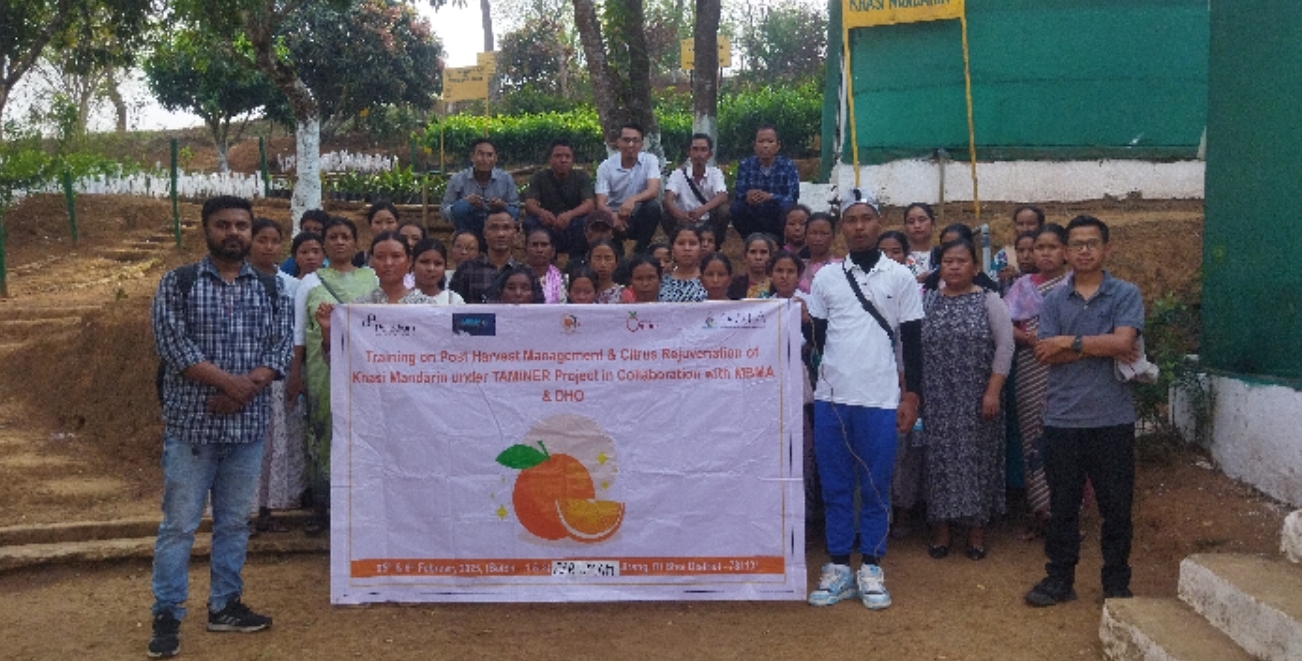The Khasi Mandarin, known for its thin peel, rich aroma, and honeyed sweetness, has long been more than just a fruit. It is a symbol of identity, pride, and livelihood for generations of farmers across Meghalaya. Cultivated for over a century in regions like East Khasi Hills, Ri-Bhoi, and West Jaintia Hills, this GI-tagged fruit is deeply interwoven into the state’s cultural and economic fabric.
But in recent years, this prized orange has fallen silent. Orchard after orchard, once heavy with fruit, have grown weary. Yields have dwindled, trees have aged, and pests have crept in unnoticed. Despite more than 10,596 hectares under cultivation, productivity lags behind at just 4.8 MT/ha, compared to the national average of 10.36 MT/ha. Farmers who once wore their orchards like a badge of honour began to question whether it was time to walk away.
“We used to wait eagerly for harvest season,” recalls Persevere Rani, Chairman of the Jirang Organic Farmer Producer Company, Umlakro, New Jirang. “But lately, we’ve been watching our trees give up. The fruit just drops before it’s ready. Some farmers have started shifting to other crops like areca nut—just to survive.”
What was happening to the Khasi Mandarin wasn’t just a farming problem—it was a cultural loss in slow motion.
That’s when a collaborative intervention under the TAMINER project, supported by the Gates Foundation and led by Palladium India, began to rewrite the story.
Recognizing that reviving the Khasi Mandarin required more than just technical tweaks, Palladium anchored a multi-partner approach that brought together scientific institutions, local organizations, and the farmers themselves. In partnership with ICAR-NEH, Umiam, and with support from MBMA and SeSTA, they designed a training and exposure visit for 41 farmers from the Jirang Organic FPC—rooted in scientific insight but grounded in the realities of Meghalaya’s agro-climatic conditions.
At ICAR’s campus, the farmers witnessed firsthand how scientific orchard management—grafting techniques, organic pest control, mulching, rejuvenation methods—could breathe new life into dying trees. What struck them wasn’t just the information, but the practicality. They could see it working. They could imagine doing it themselves.
“At ICAR Horticulture Farm, we believe that the key to transforming our farmers’ livelihoods lies in empowering them with scientific knowledge. While many still rely on traditional methods, we are committed to bridging that gap—offering quality planting materials, demonstration plots, and continuous research-backed practices. From land preparation to pest management, our goal is to equip every farmer with the tools and confidence to grow healthier crops and reap better yields. But true change begins when farmers take that first step to learn and adopt these modern techniques” says Mr. Badapbiang Dohling, a staff & trainer at the horticulture farm ICAR.
“For the first time in years, I felt hopeful,” said Rani. “Not just for my orchard, but for the future of this fruit. This wasn’t just about saving trees. It was about reclaiming something that belongs to us.”
The intervention is proving that revival isn’t just possible—it’s within reach. With Meghalaya contributing 10% of the Northeast’s mandarin output, and global interest rising for unique, organic produce, there’s a real opportunity to reposition Khasi Mandarin as a premium product on the global stage. Already, export markets in the Middle East are taking note.
But it will take more than attention to turn this into a movement. Sustained efforts to improve productivity, build pack house infrastructure, and enable collective marketing are crucial to unlocking the full potential of this indigenous treasure.
“Empowering farmers goes beyond increasing yields,” said Amit Patjoshi, CEO of Palladium India. “It’s about building resilient rural economies. With the right knowledge, tools, and market access, farmers can elevate Khasi Mandarin—an organically grown, GI-tagged fruit—into a premium product on the global stage.”
And so, in the quiet orchards of Meghalaya, the trees are beginning to bloom again—not just with fruit, but with possibility.


